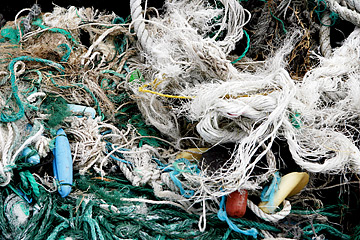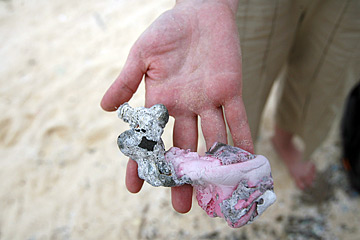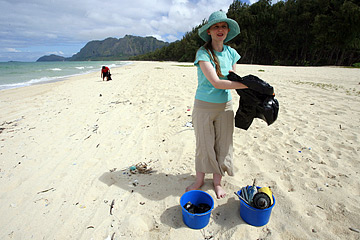
CINDY ELLEN RUSSELL / CRUSSELL@STARBULLETIN.COM
Rope and nets were left at the Waimanalo Bay State Recreation area yesterday for pickup by the National Oceanic and Atmospheric Administration.
|
|
Beach cleanup nets fewer containers
Volunteers hope it means the state recycling law works
Hawaii's annual "Get the Drift and Bag It" beach cleanup netted 34 percent fewer bottles and cans during a one-day effort in 2005 from a year earlier, which organizers and environmentalists hope is a sign that the state's recycling law is working.
"We anticipated that Hawaii's deposit program would help reduce the amount of plastic in the ocean and glass bottles on the beach," said Jeff Mikulina, state Sierra Club director. "It's great to see the results."
Beverage containers collected in last September's state cleanup totaled 15,627, down from 23,517 bottles and cans collected during the one-day cleanup in 2004, according to an International Coastal Cleanup report from the Ocean Conservancy released yesterday.

CINDY ELLEN RUSSELL / CRUSSELL@STARBULLETIN.COM
Suzanne Frazer held a piece of burned plastic. Lobster traps, toothbrushes, lighters, cigarette butts and nets are common items found on the beach.
|
|
"I think it is significant," Mikulina noted. "Although there are probably too many variables to know if it is statistically significant, it is an encouraging trend. While the overall amount of beach litter collected by this program decreased by 17 percent (between 2004 and 2005), the amount of beverage containers decreased twice as much."
"Get the Drift and Bag It" coordinator Chris Woolaway also said the change could be a "snapshot" of the effects of Hawaii's beverage container deposit law on beach cleanliness.
Since January 2005, consumers in Hawaii have been able to get a nickel for every HI-5 labeled bottle or can brought to a redemption center.
Last September, 2,206 Hawaii volunteers cleaned 87 miles of shoreline on "Get the Drift and Bag It" day, picking up 118,883 debris items and logging them by type, according to yesterday's report.

CINDY ELLEN RUSSELL / CRUSSELL@STARBULLETIN.COM
Suzanne Frazer and Dean Otsuki picked up debris yesterday at Waimanalo Beach. The Hawaii Kai residents have been cleaning the beach almost daily since April. "You can see why we can't just go for a walk and not clean up," Frazer said.
|
|
But there is still plenty of work that needs to be done, said Hawaii Kai residents Suzanne Frazer and Dean Otsuki.
Since they began taking regular walks on Windward Oahu beaches in January, the roommates have been inspired to pick up litter and coordinate beach cleanups, most recently at Bellows Beach on Sunday. They will participate in this year's cleanup Sept. 16.
"I hate to see that stuff around. I try to get as much as I can out of there," Otsuki said. "I think everybody should do something. Every little piece you pick up makes a difference."
Frazer said her home country had an intensive "Keep Australia Beautiful" campaign that she wishes Hawaii would replicate.
"I never had to clean a beach until I came here," she said.
HELP KEEP HAWAII'S BEACHES CLEAN
Hawaii's annual "Get the Drift and Bag It" cleanup, a partner in the International Coastal Cleanup, will be on Sept. 16. For more information, visit the Web site www.CoastalCleanup.org or contact county coordinators:
Oahu and state coordinator: Christine Woolaway at 753-3311 or chris@woolaway.com
Big Island: Terry Miura at 961-8695
Maui: Jan Dapitan at 877-2524
Kauai: Adam Asquith at 635-8290
HOW TO GET A HANDLE ON MARINE DEBRIS
» Dispose of trash properly. This reduces the trash that washes into streams or ditches and then the ocean.
» Make less trash. Reuse and recycle as much as possible.
» Avoid overpackaged items when shopping.
» Cut rings on six-pack holders. This lowers the risk to marine animals if the plastic does make it to sea.
» Participate in beach and river cleanups.
|

